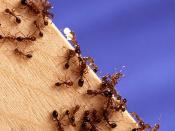Ant Foraging Ants? Who cares? Well, that what most people think, but ants are actually very interesting insects. Fire ants, Solenopsis invicta, occur in 13 states and cause millions of dollars in damage to domestic animals, wildlife, roads, and electrical systems. One of their characteristics is being able to choose a certain food (not that they don't already swarm any type of food left out) that they might need. Food searching behavior is an important yet often neglected aspect of foraging ecology. If it's winter they might choose a complex carbohydrate for energy, or a more convenient type of food that is easier to carry to the nest. If it's warmer weather they can choose more of a protein type of food. (Stephens, D. W. and Krebs) Foragers of the ant tend to return to previously rewarding sites to search for food. The search tactic depends on the type of food contracted during the previous foraging trip: a carbohydrate-stimulated local search is of the greater duration and is more spatially concentrated in the vicinity of the site of the prior find than a protein-stimulated local search.
(Fourcassie&Traniello) I wanted to try something different from peanut butter and jelly, a different source of protein and carbohydrate. I decided to use broken up hotdog portions and saltine crackers. First, the hotdogs have not only protein, but they also have lipids and the saltine crackers have a higher concentrate of calories per gram than normal breads do, as well as salt. The type of ant that I chose to do this project on the is the imported fire ant (Solenopsis invicta.) The Fire Ant's (Solenopsis invicta) habitats are in fields, woodlands, and open areas, in dry to moist soil. Their Range is Florida and Gulf states to Pacific...


